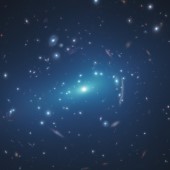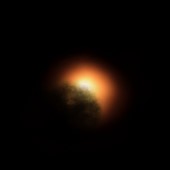ESA Science & Technology - Science Results
Science Results
Science Results
While exploring two exoplanets in a bright nearby star system, ESA's exoplanet-hunting CHEOPS satellite has unexpectedly spotted the system's third known planet crossing the face of the star. This transit reveals exciting details about a rare planet "with no known equivalent", say the researchers.
Thanks to ESA's star mapping spacecraft Gaia and machine learning, astronomers have discovered 12 quasars whose light is so strongly deflected by foreground galaxies that they are each visible as four distinct images, called an 'Einstein cross'.
ESA's exoplanet mission CHEOPS has revealed a unique planetary system consisting of six exoplanets, five of which are locked in a rare rhythmic dance as they orbit their central star. The sizes and masses of the planets, however, don't follow such an orderly pattern.
The 11-Jupiter-mass exoplanet called HD 106906 b occupies an unlikely orbit around a double star 336 light-years away and it may be offering clues to something that might be much closer to home: a hypothesized distant member of our Solar System dubbed "Planet Nine."
Solar Orbiter's latest results show that the mission is making the first direct connections between events at the solar surface and what's happening in interplanetary space around the spacecraft. It is also giving us new insights into solar 'campfires', space weather and disintegrating comets.
The motion of stars in the outskirts of our galaxy hints at significant changes in the history of the Milky Way. This and other equally fascinating results come from a set of papers that demonstrate the quality of ESA's Gaia Early third Data Release (EDR3), which is made public today.
Using data from the international Cassini-Huygens mission to Saturn and Titan, scientists have found that there are two distinct types of craters on Saturn's largest moon Titan that are still being shaped by erosion.
After years of detective work, the second touchdown site of Rosetta's Philae lander has been located on Comet 67P/Churyumov-Gerasimenko in a site that resembles the shape of a skull. Philae left its imprint in billions-of-years-old ice, revealing that the comet's icy interior is softer than cappuccino froth.
The NASA/ESA's Hubble Space Telescope has tracked the fading light of a supernova in the spiral galaxy NGC 2525, located 70 million light years away. Supernovae like this one can be used as cosmic tape measures, allowing astronomers to calculate the distance to their galaxies.
ESA's Rosetta mission has revealed a unique kind of aurora, an exciting phenomenon seen throughout the Solar System, at its target comet, Comet 67P/Churyumov-Gerasimenko.
Observations by the NASA/ESA Hubble Space Telescope and the European Southern Observatory's Very Large Telescope (VLT) in Chile have found that something may be missing from the theories of how dark matter behaves.
New observations by the NASA/ESA Hubble Space Telescope suggest that the unexpected dimming of the supergiant star Betelgeuse was most likely caused by an immense amount of hot material ejected into space, forming a dust cloud that blocked starlight coming from Betelgeuse's surface.
Taking advantage of a total lunar eclipse, astronomers using the NASA/ESA Hubble Space Telescope have detected ozone in Earth's atmosphere. This method serves as a proxy for how they will observe Earth-like planets around other stars in the search for life.
New research using data from multiple spacecraft, including ESA's Cluster mission, has revealed the cause behind the sudden brightening of the auroral oval before it breaks up into a substorm.
A global collaboration of telescopes including ESA's INTEGRAL high-energy space observatory has detected a unique mix of radiation bursting from a dead star in our galaxy – something that has never been seen before in this type of star, and may solve a long-standing cosmic mystery.
The first images from Solar Orbiter, a new Sun-observing mission by ESA and NASA, have revealed omnipresent miniature solar flares, dubbed 'campfires', near the surface of our closest star.
Two studies based on ESA's Mars Express observations of Jezero crater, the future landing site for NASA's 2020 Mars Perseverance rover, have shed light on how and when this intriguing area formed – and identified the regions most likely to reveal signs of ancient life.
An observation campaign led by ESA's XMM-Newton space observatory reveals the youngest pulsar ever seen – the remnant of a once-massive star – that is also a 'magnetar', sporting a magnetic field some 70 quadrillion times stronger than that of the Earth.
New results from the NASA/ESA Hubble Space Telescope suggest the formation of the first stars and galaxies in the early Universe took place sooner than previously thought.
The NASA/ESA Hubble Space Telescope was used to conduct a three-year study of the crowded, massive and young star cluster Westerlund 2. This is the first time that astronomers have analysed an extremely dense star cluster to study which environments are favourable to planet formation.




















